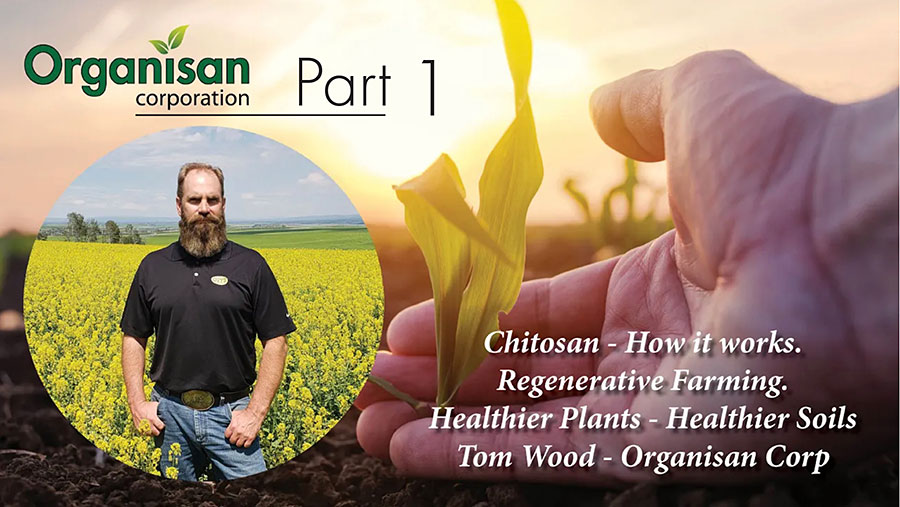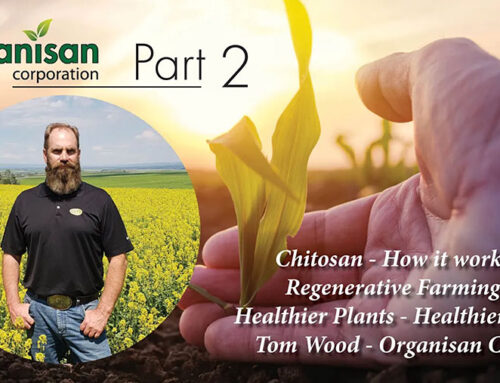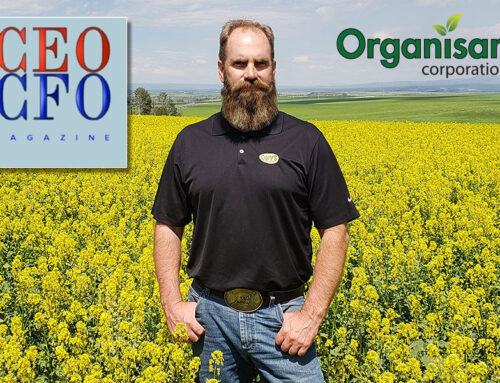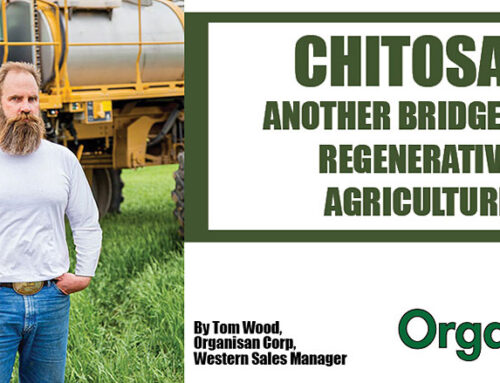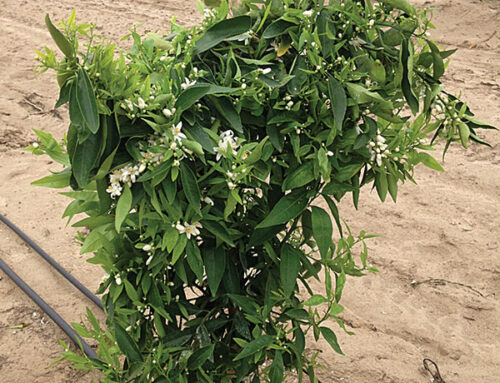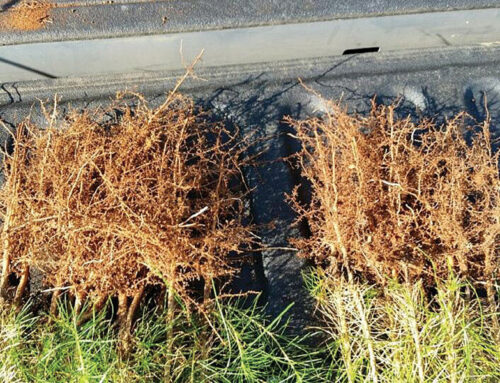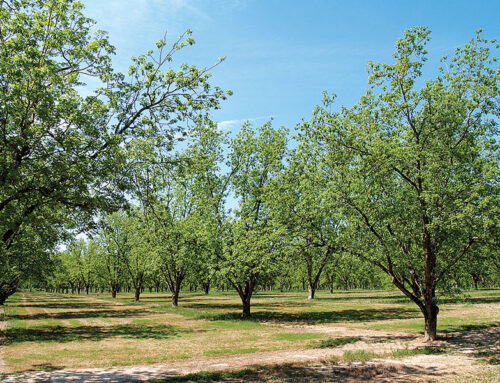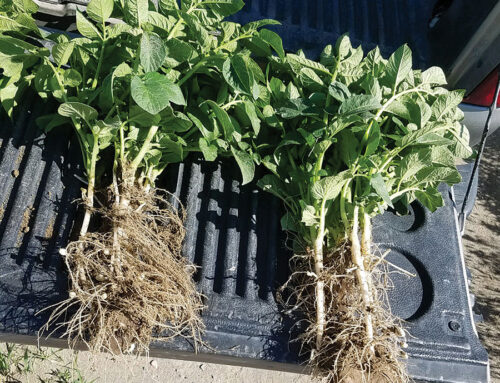If you are a farmer and you aren’t already familiar with chitin and its deacetylated derivative, chitosan, you’re about to learn a lot more about it through the lens of Tom Wood, a commercial farmer, custom crop applications developer, and most recently, Western territory manager at Organisan Corporation, headquartered in Georgia.
OII-YS™ (chitosan adjuvant) was developed in 2008 by agronomist Robin Borden and plant molecular biologist Dr. Andre Blanchard for the agricultural industry. Soon after the product development, VP of East Coast Sales and Marketing Mark Nichols and CFO Dan Dunn formed O2YS Corp. As the market demand increased, the team established Organisan Corporation as the exclusive retail partner.
From Chitin to Chitosan
Chitosan is a natural, fibrous biopolymer very closely related to cellulose. All commercial chitosan is obtained from its parent material, chitin, mainly extracted from the exoskeletons of shellfish. Second only to cellulose as the most abundant global biopolymer, it is estimated the global biological production of chitin is around 10¹¹ metric tonnes (10 gigatons).
In this conversation, Tom Wood unearths the science behind the company’s signature, “functional foundation raw material,” chitosan, and why it is front and center of Organisan’s line of biodegradable agriculture products.
As Woods explains to independent journalist Lisa Lucke, the material maximizes the bioavailability of the applications and its penetration of the soil and plant tissues. Chitosan-based products work in concert with many soil beneficials, and the combined synergy creates a far more rhizosphere-friendly environment, keeping pathogens and pests at bay.
Woods also describes the trajectory of his involvement with Organisan and how the company found its way into his life about ten years ago.
Let’s start with some background on your background and then go into the path that led you to discover chitosan and Organisan Corporation.
I grew up in Eastern Idaho on a potato, cereal grain, and alfalfa farm. We had both irrigated and dryland acres. Through the years, I built several ag-related small businesses, including a custom haying operation, and with my brother Matt, a custom retail application business focusing on biological and alternative inputs. As a commercial farmer, I was always looking for “alternative” methods, systems, and products to help lower my inputs and increase profitability.
How did chitosan enter the picture for you?
Perhaps by divine intervention, or maybe because I just stumbled onto it, I discovered chitosan following an extreme weather event we experienced in Southern Idaho in 2014. My brother and I had already started integrating microbial practices on our farm a few years before, which became the segue into regenerative agriculture practices I’m involved with now.
So, in the summer of 2014, we got so much rain that it caused many problems in our cereal grain production. We’re in an area where there is very little corn silage. Poverty wheat and barley are pretty much our mainstay and potatoes.
What problems did the massive amount of rain in 2014 cause you?
It was almost immediately apparent that we had a severe problem with DON, also called vomitoxin or head blight — it’s the same thing. One or two organisms, fusarium griminiarum, and fusarium colmorum, produce a secondary metabolite called deoxynevalenol, or D-O-N, DON for short. The DON levels that fall were through the roof. In fact, I know a farmer who once had to dig a hole and dump his barley crop in it because nobody would touch it. Once the DON levels get so high, if you force feed this onto hogs, for example, it will make them literally vomit if they try to consume it.
So, the extraordinarily high levels of these organisms in 2014 led you to do some investigation?
Yes, I had never dealt with it before, so I started researching. I found plenty of articles, and I went down a rabbit hole of sorts. That’s when I found out about a compound called chitosan and how effective it was shown to be against these two fusariums, in particular. Then, I did what I always do: I picked up the phone and started calling every agronomist I had ever worked with through our customer application business. Plus, I come from a family of crop dusters – my father started crop dusting in 1985, and my brother is currently a crop duster — so I am familiar with applying very hard chemistries.
What did the agronomists say or confirm about chitosan?
Most of them said it was probably some snake oil and that everybody would use a chitosan product as an active ingredient if it were that good. But for some reason, I just stayed with it. I mean, there are thousands of research papers on this compound that a simple Google search will pull up.
And when did it become a product you tried?
As an application specialist, I usually show up at a farmer’s door with a product that contains a specific compound for whatever problem he’s having. But in this situation, I had the compound, not the product; that’s what I was looking for the product. Eventually, after all the research I had done, my number wound up in the hands of Borden, the president, and CEO of Organisan. He called me at about eight o’clock one night, and we talked until midnight. He sent me even more research papers I hadn’t found, which surprised me.
When did you finally get some of the Organisan product on your farm?
In 2016, we brought it to Idaho to start playing with. At the time, Organisan was focused in the southeast, where it was born and bred. They didn’t have a lot of exposure in the West, so they didn’t have much advice on what crops to try it out on or the timing or rate. So we went to work figuring this out.
We ended up taking four fields and splitting them in half. In the springtime, we applied one pint per acre on broadcast before we did anything else and we saw no difference all summer. There was nothing visual, tiller counts, or kernel counts. I couldn’t see anything different until we got to yield monitors. Without them, I probably wouldn’t be here talking about it.
How significant was the difference? What was the “after” so to speak?
Between our tests and checks, we had anywhere from a seven-bushel-to-the-acre increase to a 21-bushel-to-the-acre increase. From there, it was a matter of figuring out where to apply the compound, how much, at what time, etc. We knew it worked, and we started mapping it out over time.
You’re talking to me today as the Western territory manager at Organisan. How did you go from being a customer, so to speak, to working for Organisan?
In 2018, Mark Nichols, Organisan’s VP of sales and marketing, called me and offered me a job. I told him no initially, but I would think about it and pray about it. A week later, I called him to say that if he was serious about the offer, I was serious about accepting it.
During that reflection, between the two phone calls, I thought about the timing of the opportunity. I was looking to get out of the application business because after doing it for so long, I think I probably reached a threshold for toxicity levels. I just couldn’t take the exposure anymore. So, in July of 2018, I went to work for Organisan. I could hardly believe it, but the old saying, “believe the unbelievable,” really applied to this situation. You literally sometimes have to take a leap of faith and be willing to accept and believe the unbelievable. That said, results might vary, and I can’t guarantee anyone success with this compound, but that’s what happened to me: I learned to believe the unbelievable.
Let’s switch gears and talk about the chemistry behind chitosan.
The first thing I’ll say about the actual results I saw and still see in my work and with our customers is that we can’t solve our problems with the same thinking that created them. Einstein said that, and it applies to a lot of situations. Since World War II and the “green era,” or chemistry era, we have come a long way in agriculture. However, as far as crop production yields, the increase that we’ve had, the part we don’t get told in commercial agriculture, is that more often than not, when you have an action, there’s an equal and opposite reaction.
How does this apply to agriculture exactly?
When it comes to applications, we don’t necessarily realize the connections between the solution of our underlying problem today and the next issue that solution might create, and vice versa. And this pattern is a downward spiral. The industry has done a fantastic job of breaking every one of the problems into individual compartments and then supplying farmers like me, with an individual product for an individual problem.
But we don’t see the big picture: how the solutions cannot or should not be compartmentalized.
Exactly. When you divide and conquer one at a time, more problems result. What has been missing in the industry is what I call ‘wholistic management.’ We need to manage our farms as a whole.
Do you have a quick example of that concept?
Yes. Think about a nematode application. You’re trying to solve a nematode problem with this over here, causing your white mold problem over there. There’s an underlying connection.
Let’s get down and dirty now. What is happening in the soil, in general, when you apply the chitosan compound?
A good place to start is with the SAR/SIR response. It’s often overlooked in agriculture. With chitosan, we are pre-inoculating our crops, if you will. We’re ramping up the self-defense mechanism in our plants. Chitosan flips the trigger to get your plant to ramp up its self-defense capabilities before any problems arise. That said, I want to make a note about chitosan as an insecticide.
As an insecticide, chitosan doesn’t kill bugs in the traditional sense. It’s a life-cycle interrupter. In other words, it interrupts egg lays. So if you tell me you’re overrun with aphids, that’s not where chitosan fits in because you’re already way behind. Chitosan should have been applied way before that point to keep bugs out of your field to begin with. So, as the saying goes, an ounce of prevention is worth a pound of cure.
If I asked you for a quick list, Tom, a high-level list of all the functions chitosan can provide, what would that list look like?
Well, I could give you a list of what it can provide up to this point; the list, so to speak, is a living thing in itself, and that’s because we’re continually discovering more applications for chitosan. We’re answering calls from more people like the ones I made ten years ago. For example, we’ve got golf courses in the South using our products.
But to answer your question, here’s what I’d call a partial list: As I mentioned, chitosan triggers the SAR/SIR response. It also functions as a fungicide, bactericide, virucide, insecticide, nematicide, plant elicitor, microbial stimulant, nutrient and mineral chelator. It increases stomatal conductance/transpiration control, photosynthetic rate, and cold tolerance. It is exceedingly effective as a wetting/sticking agent, especially with the addition of yucca and/or quillaja. Finally, it works as a food preservative and has tremendous frost tolerance.
Chitosan-what does it do?
- Triggers an SAR (systemic acquired response)
- Fungicide
- Bacterialcide
- Viralcide
- Insecticide
- Nematicide
- Plant Elicitor
- Microbial stimulant
- Nutrient and mineral chelator
- Increase stomatal conductance-Transpiration control
- Increases photosynthetic rate
- Increases cold tolerance
- Wetting/sticking agent, this is improved with the addition of yucca and or quillaja
- Food preservative
Tom, I know there’s much more to talk about, especially when drilling down into the science behind all of the capabilities that chitosan has proven to demonstrate across so many different applications. And we will be getting to those in future discussions. But aside from those you’ve just mentioned, is there a final thought you’d like to add or remind us about chitosan?
As one grasps the full range of what chitosan brings to commercial agriculture, it’s important to remember something we discussed early in this conversation, and that’s what I call the reductionist attitude in agriculture today. Remember the nematode example I shared? When you treat problems like nematodes without looking back and forward, what you were doing to your crop before you had the nematode problem, and where a standard nematode solution might take you going forward, you are missing the big picture. The solution to your nematode problem will likely create a phytophora problem, for example.
If you have a biological situation, a biological problem in your field, it’s because you have a biological problem. It isn’t because you have too many bad guys, like nematodes; it’s because you don’t have enough of the good guys to combat the issue before it starts. They’re all fighting for space in your crops. Prevention, prevention, prevention.
Thank you, Tom. This has been a great introduction to Chitosan, and I know we will take a much deeper dive into the many functions of chitosan and the fundamental science behind them in our next conversation. (Chitosan: How It Works with Tom Wood – Part 2)

